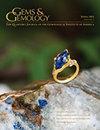Color Characteristics of Blue to Yellow Beryl from Multiple Origins
IF 1.6
3区 地球科学
Q2 MINERALOGY
引用次数: 6
Abstract
GEMS & GEMOLOGY SPRING 2020 Gem beryl is a significant gem species, including color varieties such as emerald, aquamarine, heliodor, goshenite, morganite, and red beryl. Blue to yellow beryl has been found in numerous locations, including Brazil, South Africa, Russia, Ukraine, Canada, Myanmar, the United States, Afghanistan, and China (Belakovskiy et al., 2005). Blue color in aquamarine and yellow color in heliodor are attributed to abundant Fe ions (Wood and Nassau, 1968). Fe ions are also present in all other color varieties of beryl, though Fe content is relatively low in morganite. Although discussions on the role of Fe ions in blue to yellow beryl are not new, they have mainly focused on crystal physics and chemistry. This article explores the color characteristics and chromophore ions of blue to yellow beryl using quantitative chemical and spectral analysis. The crystal structure of beryl is unique for having a peanut-shaped “channel” along the c-axis, and alkali ions in this channel interact with transition metal ions. Therefore, we will discuss the features of alkali elements and their roles in beryl color, based on analysis of the channel mechanism. This research was part of a series of ongoing studies on the color characteristics of beryl. MATERIALS AND METHODS Beryls from different origins were gathered and 14 of them with various color and alkali content were selected for this study (see table 1). They were classified in the following color varieties: goshenite (colorless to near-colorless), aquamarine (greenish blue to blue), green beryl (green to yellowish green), and heliodor (greenish yellow to yellow). With the exception of two faceted stones and one rough stone, the samples were多产地蓝、黄绿柱石的颜色特征
绿柱石是一种重要的宝石品种,包括祖母绿、海蓝宝石、日光石、歌长石、莫organite和红色绿柱石等颜色品种。蓝色到黄色的绿柱石在许多地方都有发现,包括巴西、南非、俄罗斯、乌克兰、加拿大、缅甸、美国、阿富汗和中国(Belakovskiy等,2005)。海蓝宝石的蓝色和日光石的黄色是由于富含铁离子(Wood and Nassau, 1968)。铁离子也存在于所有其他颜色的绿柱石品种中,尽管钼矿石中的铁含量相对较低。虽然对铁离子在蓝到黄绿柱石中的作用的讨论并不新鲜,但主要集中在晶体物理和化学方面。本文采用定量化学和光谱分析的方法研究了蓝绿柱石的颜色特征和发色团离子。绿柱石的晶体结构是独特的,它沿c轴有一个花生形状的“通道”,通道中的碱离子与过渡金属离子相互作用。因此,我们将在分析通道机制的基础上,探讨碱元素的特征及其在绿柱石颜色中的作用。这项研究是一系列正在进行的绿柱石颜色特性研究的一部分。材料与方法收集了不同产地的绿柱石,选取了14颗不同颜色和碱含量的绿柱石进行研究(见表1),将其分为以下颜色品种:歌绿柱石(无色至近无色)、海蓝宝石(青蓝色至蓝色)、绿绿柱石(绿色至黄绿色)和日光柱石(绿黄色至黄色)。除了两块刻面石和一块原石外,其他样品都是
本文章由计算机程序翻译,如有差异,请以英文原文为准。
求助全文
约1分钟内获得全文
求助全文
来源期刊

Gems & Gemology
地学-矿物学
CiteScore
2.90
自引率
19.20%
发文量
10
期刊介绍:
G&G publishes original articles on gem materials and research in gemology and related fields. Manuscript topics include, but are not limited to:
Laboratory or field research;
Comprehensive reviews of important topics in the field;
Synthetics, imitations, and treatments;
Trade issues;
Recent discoveries or developments in gemology and related fields (e.g., new instruments or identification techniques, gem minerals for the collector, and lapidary techniques);
Descriptions of notable gem materials and localities;
Jewelry manufacturing arts, historical jewelry, and museum exhibits.
 求助内容:
求助内容: 应助结果提醒方式:
应助结果提醒方式:


